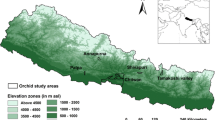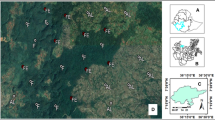Abstract
Epiphytic plant species are an important part of biological diversity. It is therefore essential to understand the distribution pattern and the factors influencing such patterns. The present study is aimed at observing the patterns of species richness, abundances and species composition of epiphytic orchids and ferns in two subtropical forests in Nepal. We also studied the relationship of host plants (Schima wallichii and Quercus lanata) and epiphyte species. Data were collected in Naudhara community forest (CF) and the national forest (NF) in Shivapuri Nagarjun National Park. The data were analyzed using univariate and multivariate tests. In total, we recorded 41 species of epiphytes (33 orchid and 8 fern species). Orchid species abundance is significantly higher in CF compared to NF. Orchid species richness and abundance increased with increasing southern aspect whereas it decreased with increasing canopy cover, and fern species richness increased with host bark roughness. Orchid abundance was positively correlated with increasing bark pH, stem size, tree age and tree height and negatively correlated with increasing steepness of the area. Likewise, fern abundances were high in places with high canopy cover, trees that were tall and big, but decreased with increasing altitude and southern aspect. The composition of the orchid and fern species was affected by altitude, aspect, canopy cover, DBH, number of forks and forest management types. We showed that the diversity of orchid and fern epiphytes is influenced by host characteristics as well as host types. The most important pre-requisite for a high epiphyte biodiversity is the presence of old respectively tall trees, independent of the recent protection status. This means: (i) for protection, e.g. in the frame of the national park declaration, such areas should be used which host such old tall trees; and (ii) also in managed forests and even in intensively used landscapes epiphytes can be protected by letting a certain number of trees be and by giving them space to grow old and tall.
Similar content being viewed by others
References
Abs C, Fischer A, Falinski JB (1999) Vegetation ecology of primeval and managed forests: Comparison of Tilio-Carpinetum-stands in the Bialowieza forest area (NortheasternPoland). Forstwissenschaftliches Centralblatt-Tharandter Forstliches Jahrbuch 118: 181–196. (In German language)
Acharya KP, Rokaya MB (2010) Medicinal orchids of Nepal: Are they well protected? Our Nature 8: 82–91. DOI: 10.3126/on.v8i1.4315
Acharya KP, Vetaas OR, Birks HJB (2011) Orchid species richness along Himalayan elevational gradients. Journal of Biogeography 38: 1821–1833. DOI: 10.1111/j.1365-2699.2011. 02511.x
Ackerman JD, Sabat A, Zimmerman JK (1996) Seedling establishment in an epiphytic orchid: an experimental study of seed limitation. Oecologia 106: 192–198. DOI: 10.1007/BF00328598
Adhikari YP (2013) Distribution pattern, micro-site conditions, host tree characteristics and utilization of epiphytic orchids in the central Himalayas. Ph.D. Thesis, Technische Universität München.
Adhikari YP, Fischer A (2011) Distribution pattern of the epiphytic orchid Rhynchostylis retusa under strong human influence in Kathmandu valley, Nepal. Botanica Orientalis: Journal of Plant Science 8: 90–99. DOI: 10.3126/botor.v8i0. 5956
Adhikari YP, Fischer A, Fischer HS (2016) Epiphytic orchids and their ecological niche under anthropogenic influence in central Himalayas, Nepal. Journal of Mountain Science 13(5): 774–784. DOI: 10.1007/s11629-015-3751-z
Adhikari YP, Fischer A, Fischer HS (2012a) Micro-site conditions of epiphytic orchids in a human impact gradient in Kathmandu valley, Nepal. Journal of Mountain Science 9: 331–342. DOI: 10.1007/s11629-009-2262-1
Adhikari YP, Fischer A, Pauleit S (2015) Sustainable conservation perspectives for epiphytic orchids in the central Himalayas, Nepal. Applied Ecology and Environmental Research 13: 753–767. DOI: 10.15666/aeer/1303_753767
Adhikari YP, Fischer HS, Fischer A (2012b) Host tree utilization by epiphytic orchids in different land-use intensities in Kathmandu Valley, Nepal. Plant Ecology 213: 1393–1412. DOI: 10.1007/s11258-012-0099-0
Callaway RM, Reinhart KO, Moore GW, et al. (2002) Epiphyte host preferences and host traits: mechanisms for speciesspecific interactions. Oecologia 132: 221–230. DOI: 10.1007/s00442-002-0943-3
Cardelús CL, Colwell RK, Watkins JE (2006) Vascular epiphyte distribution patterns: explaining the mid-elevation richness peak. Journal of Ecology 94: 144–156. DOI: 10.1111/j.1365-2745.2005.01052.x
Chaudhary RP, Subedi A, Shakya LR, et al. (2002) Orchid diversity in Arun River and Marsyangdi River valley of Nepal: distribution and conservation priorities. In: Chaudhary RP, Subedi BP, Vetaas OR, Aase TH (eds) Vegetation and society: their interaction in the Himalayas. Tribhuvan University, Nepal and University of Bergen, Norway. pp 108–117.
Christensen M, Emborg J (1996) Biodiversity in natural versus managed forest in Denmark. Forest Ecology and Management 85: 47–51
Crawley MJ (2012) The R Book, 2 edition. Wiley, Chichester, West Sussex, United Kingdom.
Desender K, Ervynck A, Tack G (1999) Beetle diversity and historical ecology of woodland in Flanders. Belgian Journal of Zoology 129: 139–155.
Dettki H, Per-Anders E (1998) Epiphytic microlichens in managed and natural forest landscapes: A comparison at two spatial scales. Ecography 21: 613–624. DOI: 10.1111/j.1600-0587.1998.tb00554.x
Devkota MP, Macklin J, Nickrent DL (2015) The status of the mistletoe genus Dufrenoya Chatin (Amphorogynaceae) with a specific focus on Nepal. Flora-Morphology, Distribution, Functional Ecology of Plants 215: 75–83. DOI: 10.1016/j.flora.2015.07.009
Do HM (2015) Department Of Hydrology and Meteorology. Ministry of Science, Technology & Environment, Kathmandu, Nepal.
Dufrêne M, Legendre P (1997) Species assemblages and indicator species: the need for a flexible asymmetrical approach. Ecological monographs 67: 345–366. DOI: 10.1890/0012-9615(1997)067[0345: SAAIST]2.0.CO;2
Farmer AM, Bates JW, Bell JNB (1990) A comparison of methods for the measurement of bark pH. The Lichenologist 22: 191–194. DOI: 10.1017/S0024282990000147
Fazey I, Fischer J, Lindenmayer DB (2005) What do conservation biologists publish? Biological Conservation 124: 63–73. DOI: 10.1016/j.biocon.2005.01.013
Flores-Palacios A, García-Franco JG (2006) The relationship between tree size and epiphyte species richness: testing four different hypotheses. Journal of Biogeography 33: 323–330. DOI: 10.1111/j.1365-2699.2005.01382.x
Fraser-Jenkins CR, Kandel DR, Pariyar S (2015) Fern and Fernallies of Nepal. National Herbarium and Plant Laboratories, Department of Plant Resources, Ministry of Forest and Soil Conservation, Government of Nepal, Nepal.
Gentry AH, Dodson CH (1987) Diversity and biogeography of Neotropical vascular epiphytes. Annals of the Missouri Botanical Garden 74: 205–233. DOI: 10.2307/2399395
Ghimire M (2008) Epiphytic orchids of Nepal. Banko Janakari 18: 53–63. DOI: 10.3126/banko.v18i2.2173
Graham EA, Andrade JL (2004) Drought tolerance associated with vertical stratification of two co-occurring epiphytic Bromeliads in a tropical dry forest. American Journal of Botany 91: 699–706. DOI: 10.3732/ajb.91.5.699
Hietz P (1999) Diversity and conservation of epiphytes in a changing environment. Pure and Applied Chemistry 70: 1–11.
Hirata A, Kamijo T, Saito S (2009) Host trait preferences and distribution of vascular epiphytes in a warm-temperate forest. Plant Ecology 201: 247–254.DOI: 10.1007/s11258-008-9519-6
Ingram SW, Ferrell-Ingram K, Nadkarni NM (1996) Floristic composition of vascular epiphytes in a neotropical cloud forest, Montever, Costa Rica. Selbyana 17: 88–103.
Ingram SW, Lowman MD (1995) The collection and preservation of plant material from the tropical forest canopy. In: Lowman MD, Nadkarni NM (eds) Forest Canopies. Forest Canopies Academic, San Diego, California, USA. pp 5–15
Köster N, Friedrich K, Nieder J, Barthlott W (2009) Conservation of epiphyte diversity in an Andean landscape transformed by human land use. Conservation Biology 23: 911–919. DOI: 10.1111/j.1523-1739.2008.01164.x
Köster N, Nieder J, Barthlott W (2011) Effect of host tree traits on epiphyte diversity in natural and anthropogenic habitats in Ecuador. Biotropica 43: 685–694. DOI: 10.1111/j.1744-7429.2011.00759.x
Lepš J, Šmilauer P (2014) Multivariate Analysis of Ecological Data Using CANOCO 5, 2nd edn. Cambridge University Press, UK.
Lõhmus A (2009) Factors of species-specific detectability in conservation assessments of poorly studied taxa: The case of polypore fungi. Biological Conservation 142: 2792–2796. DOI: 10.1016/j.biocon.2009.05.022
McCune B, Mefford M (2011) Multivariate Analysis of Ecological Data. Version 6. MjM Software, Gleneden Beach, Oregon, USA.
Otero JT, Aragón S, Ackerman JD (2007) Site variation in spatial aggregation and phorophyte preference in Psychilis monensis (Orchidaceae). Biotropica 39: 227–231.DOI: 10.1111/j.1744-7429.2006.00258.x
Paillet Y, Bergè SL, HjäLté NJ, et al. (2010) Biodiversity differences between managed and unmanaged forests: Metaanalysis of species richness in Europe. Conservation Biology 24: 101–112. DOI: 10.1111/j.1523-1739.2009.01399.x
Press JR, Shrestha KK, Sutton DA (2000) Annotated checklist of the flowering plants of Nepal. Natural History Museum, London and Central Department of Botany, Tribhuvan University, Kathmandu.
Rokaya MB, Raskoti BB, Timsina B, et al. (2013) An annotated checklist of the orchids of Nepal. Nordic Journal of Botany 31: 511–550. DOI: 10.1111/j.1756-1051.2013.01230.x
Schmidt W (2005) Herb layer species as indicators of biodiversity of managed and unmanaged beech forests. Forest Snow and Landscape Research 79: 111–125.
Song L, Liu W, Ma W, Tan Z (2010) Bole epiphytic bryophytes on Lithocarpus xylocarpus (Kurz) Markgr. in the Ailao Mountains, SW China. Ecol Res 26: 351–363. DOI: 10.1007/s11284-010-0790-3
S-Plus (2000) Professional Edition for Windows, Release 2. MathSoft, Inc.
Stuntz S, Ziegler C, Simon U, Zotz G (2002) Diversity and structure of the arthropod fauna within three canopy epiphyte species in central Panama. Journal of Tropical Ecology 18: 161–176. DOI: 10.1017/S0266467402002110 ter
Braak CJF, Smilauer P (2012) Canoco 5, Windows release (5.04). The Netherlands and Czech Republic: Biometris, Plant Research International.
Thapa N (2002) Pteridophytes of Nepal. Bulletin of the Department of Plant Resources, Department of Plant Resources, Ministry of Forests and Soil Conservation, His Majesty’s Government of Nepal, Nepal.
Timsina B, Rokaya MB, Münzbergová Z, et al. (2016) Diversity, distribution and host-species associations of epiphytic orchids in Nepal. Biodiversity and Conservation 25: 2803–2819. DOI: 10.1007/s10531-016-1205-8
Turner IM, Tan HTW, Wee YC, et al. (1994) A Study of plant species extinction in Singapore: Lessons for the conservation of tropical biodiversity. Conservation Biology 8: 705–712. DOI: 10.1046/j.1523-1739.1994.08030705.x
Väisänen R, Biström O, Heliövaara K (1993) Sub-cortical Coleoptera in dead pines and spruces: is primeval species composition maintained in managed forests? Biodiversity and Conservation 2: 95–113. DOI: 10.1007/BF00056127
Wagner K, Mendieta-Leiva G, Zotz G (2015) Host specificity in vascular epiphytes: a review of methodology, empirical evidence and potential mechanisms. AoB PLANTS plu092. DOI: 10.1093/aobpla/plu092
Webb EL, Sah RN (2003) Structure and diversity of natural and managed sal (Shorea robusta Gaertn.f.) forest in the Terai of Nepal. Forest Ecology and Management 176: 337–353. DOI: 10.1016/S0378-1127(02)00272-4
Werner FA, Gradstein SR (2009) Diversity of dry forest epiphytes along a gradient of human disturbance in the tropical Andes. Journal of Vegetation Science 20: 59–68. DOI: 10.1111/j.1654-1103.2009.05286.x
Wolf J, Beusen AHW, Groenendijk P, et al. (2003) The integrated modeling system STONE for calculating nutrient emissions from agriculture in the Netherlands. Environmental Modelling & Software 18: 597–617. DOI: 10.1016/S1364-8152(03)00036-7
Wolf JH, Flamenco-S A (2003) Patterns in species richness and distribution of vascular epiphytes in Chiapas, Mexico. Journal of Biogeography 30: 1689–1707. DOI: 10.1046/j.1365-2699. 2003.00902.x
Wolf JHD (2005) The response of epiphytes to anthropogenic disturbance of pine-oak forests in the highlands of Chiapas, Mexico. Forest Ecology and Management 212: 376–393. DOI: 10.1016/j.foreco.2005.03.027
Wolf JHD, Gradstein SR, Nadkarni NM (2009) A protocol for sampling vascular epiphyte richness and abundance. Journal of Tropical Ecology 25: 107–121. DOI: 10.1017/S0266467408 005786
Zotz G (2007) Johansson revisited: the spatial structure of epiphyte assemblages. Journal of Vegetation Science 18: 123–130. DOI: 10.1111/j.1654-1103.2007.tb02522.x
Zotz G, Laube S, Schmidt G, Pugnaire F (2005) Long-Term Population Dynamics of the Epiphytic Bromeliad, Werauhia sanguinolenta. Ecography 28: 806–814. DOI: 10.1111/j.2005. 0906-7590.04292.x
Acknowledgments
We are indebted to “Bauer-Stiftung und Glaser-Stiftung im Stifterverband für die Deutsche Wissenschaft” Project No. T237/24905/2013/Kg for the research grant. Maan B. Rokaya would like to acknowledge grant number 14-36098G of the Czech Science Foundation and the institutional support RVO 67985939. We are indebted to Zuzana Münzbergová for helping us with the data analysis and for providing useful comments. We thank the Shivapuri Nagarjun National Park authorities and the Naudhara Community Forest Committee, Phulchowki, Godavari, for the permission to carry out the research in this forest. We wish to express our thanks also to anonymous reviewers for their critical reading and valuable comments on previous versions of the manuscript. We would like to thank Bishnu P. Bhattarai for the map preparation.
Author information
Authors and Affiliations
Corresponding authors
Additional information
http://orcid.org/0000-0003-1963-214X
http://orcid.org/0000-0002-6781-2594
http://orcid.org/0000-0003-1929-5331
http://orcid.org/0000-0003-1459-093X
http://orcid.org/0000-0003-0533-1987
http://orcid.org/0000-0001-9104-7362
Electronic supplementary material
Rights and permissions
About this article
Cite this article
Adhikari, Y.P., Fischer, A., Fischer, H.S. et al. Diversity, composition and host-species relationships of epiphytic orchids and ferns in two forests in Nepal. J. Mt. Sci. 14, 1065–1075 (2017). https://doi.org/10.1007/s11629-016-4194-x
Received:
Revised:
Accepted:
Published:
Issue Date:
DOI: https://doi.org/10.1007/s11629-016-4194-x




